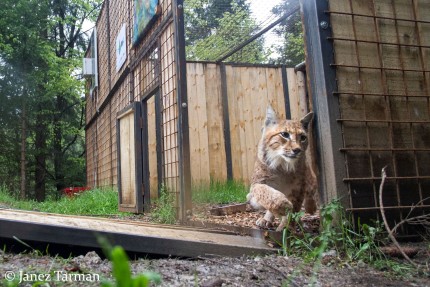First two lynx translocated to Slovenia and Croatia in an effort to save an endangered population
Today Slovenian hunters from Loški Potok released a lynx named Goru into the wild. He is the firs of 10 lynx that will be brought to Slovenia to save the Dinaric-SE Alpine lynx population fro extinction. Goru was transferred from Romania to Slovenia on April 26th and was placed in a enclosure in Loški Potok, where he adjusted to his new environment, a procedure known as a sof release. Release was done by project LIFE Lynx.

Release of Lynx Goru in Loški Potok
During the adjustment, he was cared for by local hunters from Loški Potok hunting club, and veterinarian and Slovenian LIFE Lynx project team members. This soft release procedure was chosen to minimize the chances that the lynx will move far from the release site.
In the beginning of May, a lynx named Doru was released into the wild to Risnjak National Park in Croatia. Goru and Doru are the first two of the 14 planned translocated lynx to save the Dinaric-SE- Alpine lynx population from extinction. Both lynx are equipped with GPS radio collars, that will enable LIFE Lynx researchers to track their movements and confirm if the lynx are being integrated in the population.
With this translocation, the LIFE Lynx project continues the work of hunters, foresters and biologist, that reintroduced lynx to the Dinaric Mountains in 1973. While the 1973 reintroduction of 6 animals was at first a tremendous success and the population rapidly increased in numbers and range, in the following decades the population remained isolated from neighboring lynx populations. This meant that descendants of reintroduced lynx could only mate with each other, which lead to inbreeding depression and decline of the population. Today, this population has the lowest genetic diversity of all studied lynx populations and inbreeding has reached a critical level. Since genetic deterioration is the major factor threatening these lynx, the main goal of the population reinforcement is to improve the genetic outlook and reverse the population decline.
Dr. Tomaž Skrbinšek – Wildlife Geneticist – University of Ljubljana: "In small populations, or populations originating from just a handful of founders, animals soon have only the option to mate with close relatives, or not mate at all. This is what happened with lynx that were reintroduced in the Dinaric Mountains in 1973. Without new lynx, our population will inevitably go extinct in the near future."
The translocations are part of the LIFE Lynx project funded through the EU LIFE Programme. The project plans translocations of 14 lynx from the closest healthy lynx population in the Carpathian Mountains of Slovakia and Romania to the Dinaric Mountains and Alps in Slovenia and Croatia. There are 5 countries and 11 partners involved in the project.
Rok Černe, LIFE Lynx project coordinator: »Translocation of the two lynx from Romania to the Dinaric Mountains is of historic importance for conservation of this species at the European level. These are the first two lynx that Romania has contributed to a European level population reinforcement effort. We are grateful and appreciate hard work that our Romanian partners have made to lynx conservation.«
More information about the project https://www.lifelynx.eu/ and life.lynx.eu@gmail.com.
Follow us on Facebook: https://www.facebook.com/LIFELynx.eu/
and https://www.facebook.com/lifelynx.hr/
source: https://www.lifelynx.eu/project-outputs/
